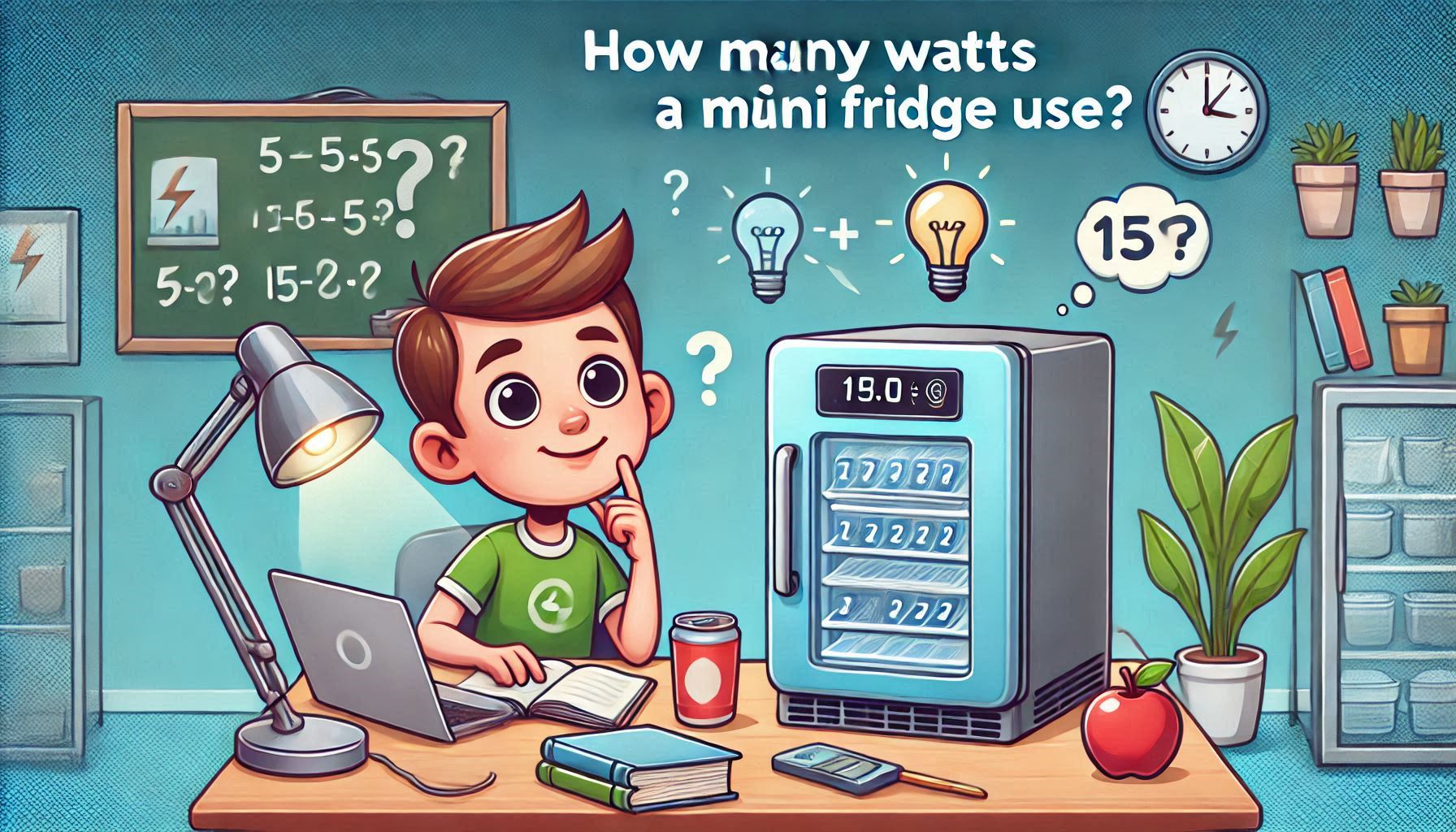Mini fridges are a fantastic solution for keeping your drinks cold and snacks fresh without taking up too much space. But before plugging one into your dorm room, office, or RV, have you ever wondered, how many watts does a mini fridge use? Understanding the energy consumption of mini fridges is not only practical but can also help you manage your electricity bills more effectively. In this guide, we’ll answer your questions about wattage, energy efficiency, and how much power mini-fridges consume.
What Is a Mini Fridge and Why Is It So Popular?
A mini fridge is a compact refrigeration unit, typically smaller than 5 cubic feet, designed for personal or small-scale use. They’re commonly found in bedrooms, dorms, offices, and even RVs. But their popularity isn’t just about size; they’re also energy-efficient and budget-friendly.
Key Benefits of Mini Fridges
- Space-saving: Perfect for tight spaces.
- Energy-efficient: Consumes less power compared to standard refrigerators.
- Convenience: Keeps food and drinks easily accessible.
- Cost-effective: Affordable to purchase and maintain.
Now, let’s dive deeper into the energy consumption of mini-fridges.
How Many Watts Does a Mini Fridge Use?
The wattage of a mini fridge can vary depending on its size, model, and energy efficiency rating. On average, mini-fridges use 50–100 watts when running, but this can fluctuate depending on internal temperature, ambient environment, and usage patterns. If you’re asking, How many watts does a mini fridge use, this section will break down the key factors that influence its energy consumption.
Factors That Affect Mini Fridge Wattage
When considering how many watts does a mini fridge uses, several factors can play a role in determining its energy consumption. These include:
- Size and Capacity: Larger mini-fridges typically consume more power.
- Energy Star Rating: Energy-efficient mini-fridges consume fewer watts, making them a good option if you’re concerned about power usage.
- External Temperature: Warmer surroundings make the fridge work harder.
- Usage Patterns: Frequent opening of the door increases energy consumption.
To determine the exact wattage of your mini fridge, check the manufacturer’s label or user manual. Most labels list the appliance’s wattage or amperage.
How to Calculate Energy Costs for a Mini Fridge
Knowing how many watts does a mini fridge uses is just the first step in managing its energy consumption. Here’s a simple guide to help you calculate your mini fridge’s electricity costs:
Step-by-Step Guide to Calculate Energy Costs
- Find the Wattage: Look for the wattage on the label (e.g., 75 watts).
- Estimate Daily Usage: Most mini fridges run for about 8 hours a day.
- Convert to Kilowatts: Divide the wattage by 1,000 (e.g., 75 watts ÷ 1,000 = 0.075 kW).
- Multiply by Hours: Multiply the kilowatts by daily usage hours (0.075 kW × 8 hours = 0.6 kWh/day).
- Check Your Electricity Rate: Look at your electric bill for the cost per kWh (e.g., $0.13/kWh).
- Calculate Monthly Cost: Multiply daily usage by 30 days and your electricity rate (0.6 kWh/day × 30 × $0.13 = $2.34/month).
This will help you determine the cost of running a mini fridge and understand how many watts it uses in a month.
Energy-Saving Tips for Mini Fridges
If you want to lower the power consumption of your mini fridge, here are some tips to help reduce the amount of watts a mini fridge uses:
1. Choose an Energy-Efficient Model
Look for fridges with the Energy Star certification, guaranteeing better energy efficiency without compromising performance.
2. Keep the Fridge Full
A full fridge retains cold air better than an empty one, reducing the compressor’s workload and the number of watts mini-fridges use.
3. Avoid Overloading
While stocking your mini fridge is good, overloading it can restrict airflow, causing the compressor to use more watts.
4. Place It in a Cool Spot
Keeping your mini fridge in a shaded area away from heat sources reduces the energy required to maintain a cool temperature.
5. Regular Maintenance
Clean the coils and ensure the door seals are intact to maintain efficiency.
How Mini Fridges Compare to Full-Size Refrigerators
Wondering how many watts a mini fridge uses compared to a full-size refrigerator? Here’s a quick comparison:
| Feature | Mini Fridge | Full-Size Refrigerator |
| Average Wattage | 50–100 watts | 200–600 watts |
| Energy Usage (kWh/month) | ~20 kWh | ~60–100 kWh |
| Ideal For | Small spaces, personal use | Family use, larger storage |
By adding How Many Watts Does a Mini Fridge Use in relevant sections, you ensure the article remains optimized for search engines while maintaining its natural flow.
Purchasing a Mini Fridge:
When you’re ready to buy a mini fridge, there are several online retailers offering a wide selection of models, including energy-efficient ones. For a variety of options, check out Best Buy’s Mini Fridges.
Common Mistakes When Using Mini Fridges
When operating a mini fridge, there are common mistakes that can lead to increased energy consumption and higher watt usage. These include:
1. Ignoring Ventilation Space
Mini fridges need proper airflow around them for optimal performance. Blocked ventilation increases the wattage consumption as it overworks the compressor.
2. Not Defrosting Regularly
Ice buildup can cause the fridge to work harder, increasing the watts used. Regularly defrosting will help maintain efficiency.
3. Setting the Temperature Too Low
Setting your mini fridge’s temperature too low uses more watts than necessary. Stick to the recommended temperature to save power.
Anecdote: My Mini Fridge Energy Experiment
Last summer, I decided to track the energy consumption of my mini fridge. Using an electricity usage monitor, I found out that my fridge used an average of 72 watts per hour. Over a month, it cost me just $2.80 to operate! This small investment was worth the convenience it provided, keeping my beverages cool and snacks fresh during those hot days.
Frequently Asked Questions About Mini Fridge Wattage
1. How can I find the wattage of my mini fridge?
Check the manufacturer’s label, usually located on the back or inside the fridge. It may list the wattage or amperage.
2. Do mini-fridges consume power when not in use?
Yes, if they’re plugged in, they draw a small amount of standby power. Unplugging when not in use can save energy.
3. Are mini fridges energy-efficient?
Yes, especially modern models with Energy Star ratings. They’re designed to consume minimal electricity.
Conclusion: Make an Informed Choice
Understanding how many watts a mini fridge uses can help you make an informed decision about purchasing or operating one. By choosing energy-efficient models and following simple energy-saving tips, you can enjoy the benefits of a mini fridge without worrying about high electricity bills.
Whether you’re setting up a cozy dorm room, sprucing up your office, or planning a road trip, a mini fridge is an excellent companion. Now that you know the ins and outs of their energy consumption, you can enjoy your chilled snacks and drinks guilt-free!
For more information on energy-efficient appliances, check out Portable Aircon Wattage to make an informed choice about cooling options as well.
Start your journey toward smarter energy use today! Find the best mini fridge for your needs and keep your power usage in check.


